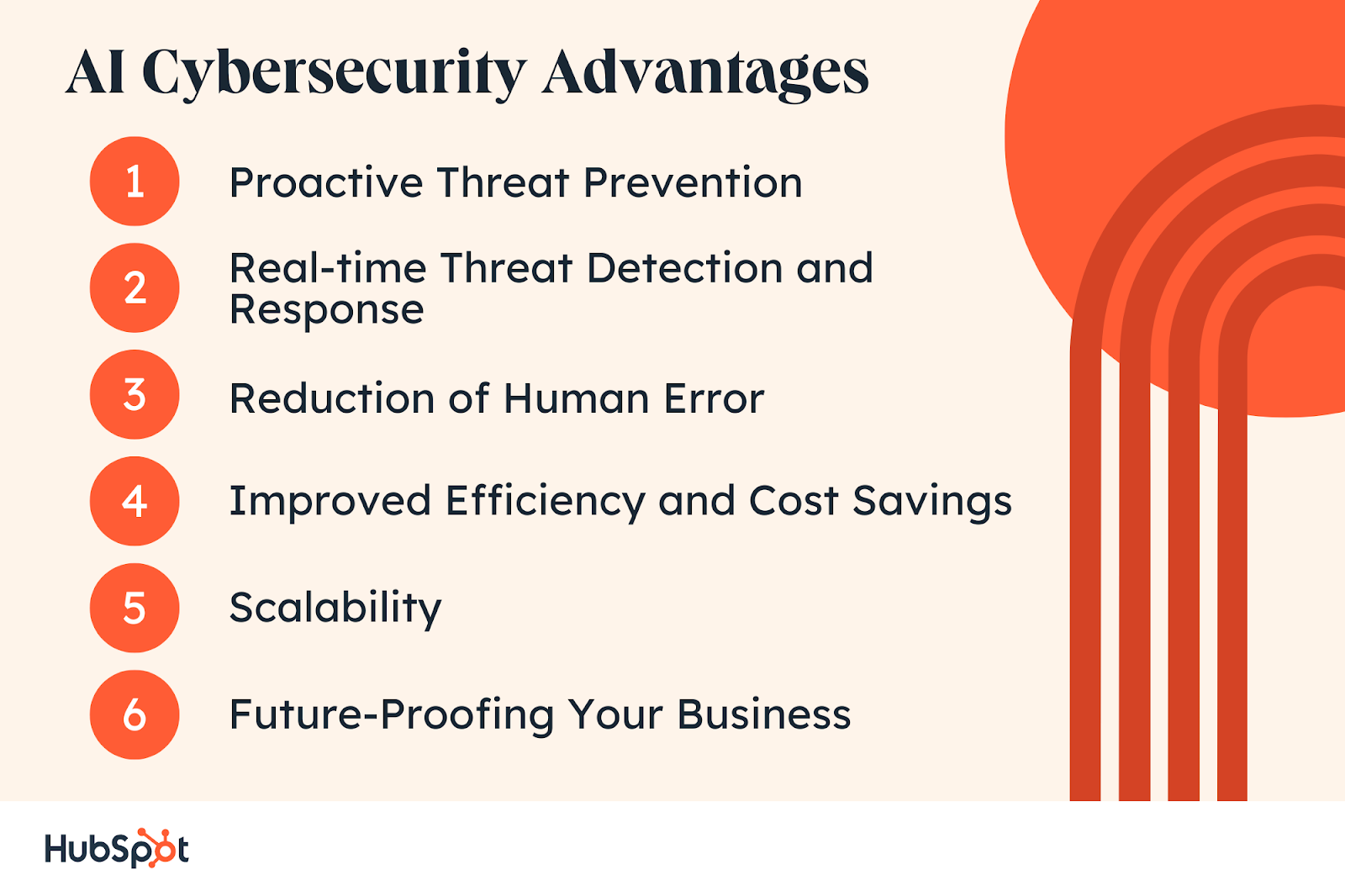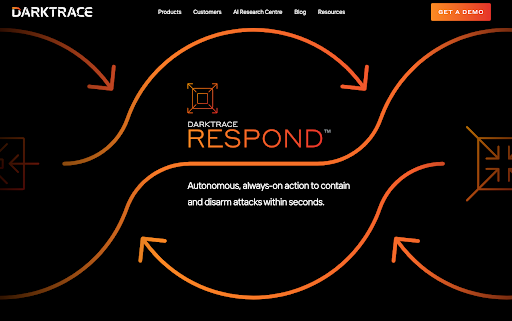AI has become an indispensable weapon in the combat against cybercrime. According to Forbes, 76% of businesses are earmarking AI and machine learning as key priorities within their IT budgets.
This escalating trend is largely fueled by the exponential increase in data required to detect cyber threats. For example, connected devices alone will generate 79 zettabytes of data by 2025, an unmanageable volume for manual human analysis.
Recent research by Blackberry reveals that 82% of IT decision-makers plan to infuse their cybersecurity strategies with AI within the next two years. In this article, we’re breaking down the ins and outs of AI cybersecurity solutions. Let’s dive in.
How can AI help cybersecurity?
The Advantages of AI Cybersecurity
What is AI cybersecurity?
AI, or Artificial Intelligence, is ushering in a computing power and learning ability reshaping the world as we know it. It refers to the capability of a machine to mimic intelligent human behavior.
Now, combine that with cybersecurity, a field dedicated to protecting systems, networks, and programs from digital attacks — and you’ve got AI cybersecurity.
AI cybersecurity integrates artificial intelligence into cybersecurity protocols to predict, identify, and neutralize potential cyber threats.
It’s about empowering your defense systems to learn from past incidents, adapt in real-time to current situations, and even anticipate future threats.
Imagine a goalkeeper who doesn‘t just defend, but learns the common shooting patterns of every striker, understands the wind direction, and predicts the ball’s trajectory even before it‘s kicked. That’s what AI brings to cybersecurity.
AI turns your defense from reactive to proactive, capable of intelligent decision-making, and infinitely more resilient in cyber-attacks.
AI cybersecurity is no longer a nice-to-have but a necessity for every organization, regardless of size or industry. It’s the next-generation shield for your digital assets and a robust answer to the evolving sophistication of cyber threats.
How can AI help cybersecurity?
As we plunge deeper into the digital age, our reliance on technology has never been greater — and neither has the potential risks. Enter AI, a shining knight in digital armor, bringing a wealth of solutions to the cybersecurity field.
But how exactly does AI lend its power to bolster cybersecurity efforts? Consider the following.
Predictive Capabilities
AI algorithms, particularly those utilizing machine learning, can analyze historical data to identify patterns and trends. This ability allows them to predict potential threats and vulnerabilities before exploitation.
Imagine being able to forecast a storm before the first drop of rain — that’s what AI brings to your cybersecurity table.
Real-Time Response
Cyber threats don‘t wait, and neither should your defenses. AI can monitor networks and systems 24/7, identifying and neutralizing threats in real-time.
It’s like having a vigilant security guard that never sleeps, equipped with the most brilliant surveillance tools.
Enhanced Accuracy
AI significantly reduces the chances of false positives and negatives in threat detection.
By learning from historical data and adapting its understanding over time, AI can pinpoint genuine threats highly, minimizing the risk of overlooking a real danger or flagging a benign activity.
Automated Tasks
AI can take over routine cybersecurity tasks such as monitoring network traffic or analyzing user behavior, freeing your human talent to focus on more complex issues. It’s about working smarter, not harder.
Advanced Threat Intelligence
AI-powered threat intelligence can dive deep into the dark web, monitor threat actors, and uncover potential risks that could go unnoticed by traditional methods. It’s like having a detective who can find clues invisible to the human eye.
Scalability
As your business grows, so too do your cybersecurity needs. AI can scale effortlessly, providing continuous protection regardless of the data volume or the network size.
The Advantages of AI Cybersecurity
Harnessing AI for cybersecurity presents a wealth of benefits. It offers a dynamic defense system against cyber threats, streamlines operations, enhances efficiency, and opens up new avenues for growth.
Let’s discuss the benefits of incorporating AI into your cybersecurity strategy.

Proactive Threat Prevention
One of the critical advantages of AI cybersecurity is its ability to shift from a reactive to a proactive approach.
AI can analyze past and present data through machine learning algorithms, learning to recognize patterns and predict potential threats.
This predictive capability allows organizations to identify and neutralize threats before they have a chance to impact business operations.
Real-time Threat Detection and Response
AI’s real-time monitoring capabilities are second to none. It can analyze vast quantities of data around the clock, detecting threats as they occur.
When milliseconds can distinguish between a successfully repelled attack and a significant data breach, AI’s speedy response time becomes a vital asset.
Reduction of Human Error
Human error is a leading cause of cybersecurity breaches. By automating routine tasks and decision-making processes, AI reduces the potential for human mistakes.
This leads to a more secure, reliable system that operates effectively even during a threat.
Improved Efficiency and Cost Savings
AI can handle a volume of data analysis that would be impossible for human analysts to achieve, freeing them to focus on complex, strategic tasks.
This shift can lead to significant cost savings and improved operational efficiency, transforming your cybersecurity operations from a cost center to a strategic asset.
Scalability
As businesses grow and data volumes increase, cybersecurity needs can quickly outstrip resources. With its inherent scalability, AI can adapt and grow alongside your business, ensuring robust defense regardless of the volume or complexity of threats.
Future-Proofing Your Business
The cybersecurity landscape is constantly evolving, with new threats emerging every day. AI’s ability to learn and adapt makes it uniquely positioned to respond to these changing threats, keeping your business secure now and in the future.
In a digital age, leveraging AI in cybersecurity is not just an advantage — staying ahead of the curve is necessary.
AI Cybersecurity Examples
Understanding the power of AI in cybersecurity is one thing, but seeing it in action brings a new level of clarity. Here are three examples of companies leveraging AI to enhance their cybersecurity strategies.
Mastercard’s Decision Intelligence
Mastercard’s Decision Intelligence is a fantastic example of AI’s power in cybersecurity.
This solution applies AI and machine learning to analyze and score real-time transactions, helping reduce fraudulent transactions without adding friction for legitimate customers.
By learning from each transaction, Decision Intelligence can continually adapt and improve its ability to detect fraudulent activity, highlighting AI’s potential for ongoing learning and improvement.
BAE Systems
BAE Systems, a British multinational defense, security, and aerospace company, has deployed AI to boost its cybersecurity efforts.
They utilize machine learning algorithms to analyze network activity and identify unusual patterns that could signify a threat.
The company’s AI solutions provide ongoing monitoring and real-time threat detection, keeping their sensitive information and systems secure.
PayPal
Online payment giant PayPal uses an AI-based system to help combat money laundering and detect fraudulent transactions.
PayPal’s AI system analyzes transactions in real-time, spotting suspicious activity and helping to prevent illegal transactions. The system learns from each transaction, improving its accuracy and effectiveness.
AI Cybersecurity Solutions
Harnessing the power of AI in your cybersecurity strategy requires robust tools.
Here are five of the top AI-powered cybersecurity solutions on the market which can equip your sales teams with the defenses they need to protect valuable customer data and secure your digital infrastructure.
1. Darktrace RESPOND

Darktrace, a global leader in cyber defense, utilizes AI novelly with its Autonomous Response technology, RESPOND.
By learning what constitutes normal behavior for a network, its AI can recognize anomalous activity, whether it be an external cyberattack or an insider threat.
When a potential threat is identified, Darktrace‘s AI can take precise, proportionate action in real-time to neutralize it, all while updating its understanding of what is typical for future reference.
It’s a shining example of AI’s learning capabilities put to practical, effective use in cybersecurity.
Core Features
- Autonomous threat response
- Continuous learning and adaptation
- Real-time threat visualization
Pricing: Contact Darktrace for pricing information.
Best for: Businesses of all sizes seeking a high degree of automation in their cybersecurity defenses.
What we like: The impressive self-learning AI technology provides autonomous responses that adapt and improve over time.
2. IBM Watson for Cybersecurity
IBM’s Watson needs no introduction in the AI world. Known for its success in healthcare and game shows, Watson has also made waves in cybersecurity.
Watson for Cyber Security uses cognitive technology to analyze vast information — from countless blogs, articles, and threat intelligence reports to identify potential threats.
By sifting through this data more efficiently than any human team could, Watson enables security analysts to respond to threats with unmatched speed and insight.
Core Features
- Natural language processing to analyze various data sources
- Cloud-based cognitive computing for scalability
- Integration with existing security tools
Pricing: Contact IBM for pricing information.
Best for: Large businesses and enterprises that require robust, scalable cybersecurity solutions.
What We Like: Watson’s ability to process vast data and integrate it with existing tools makes it a versatile solution.
3. CrowdStrike Falcon
CrowdStrike, a pioneer in cloud-delivered endpoint protection, leverages AI in its Falcon platform. Falcon uses machine learning algorithms to analyze data and detect threats.
This AI-powered platform offers real-time protection, even when the endpoints are offline. It continually learns from the troves of data it processes, improving its threat detection capabilities over time.
This demonstrates AI’s unparalleled scalability and evolution in action.
Core Features
- AI-based threat detection and prevention
- 24/7 threat hunting
- Cloud-native architecture
Pricing: Pricing is available upon request.
Best for: Businesses of all sizes, particularly those with remote workforces.
What we like: Falcon’s cloud-native structure allows scalability and remote threat management, which is particularly useful for distributed teams.
4. Cybereason
Cybereason offers an AI-powered platform that delivers endpoint protection, detection, and response to secure your business assets. It uses multiple layers of machine learning to uncover malware and ransomware attacks.
It also provides predictive protection, detection, and response once these attacks are detected.
Core Features
- Endpoint protection
- Behavioral-based threat detection
- Automated threat responses
Pricing: Contact Cybereason for pricing information.
Best for: Businesses of all sizes that want a comprehensive, AI-based cybersecurity solution.
What we like: Cybereason’s behavioral-based detection provides an extra layer of security by identifying potential internal threats.
5. Vectra
Vectra’s Cognito platform is an AI-powered network detection and response solution that prioritizes threats in real-time and accelerates investigations.
The platform embraces its ability to prioritize urgency based on the threat environment and quickly stop attacks.
Core Features
- Real-time cyber attack detection and prioritization
- Automated threat hunting
- Integration with endpoint response solutions
Pricing: Contact Vectra for pricing details.
Best for: Mid-size to large businesses that require sophisticated threat detection and prioritization.
What we like: Prioritizing threats helps security teams focus on the most pressing issues, enhancing efficiency and response times.
Your business’s right AI cybersecurity solution will depend on your needs, budget, and resources. But whether you’re a growing startup or an established enterprise, the AI revolution in cybersecurity offers potent tools for safeguarding your digital assets.
Embracing the Future of AI Cybersecurity
As we continue to embrace our digital future, cybersecurity will undoubtedly remain a crucial area of focus for businesses around the globe.
With the ever-evolving landscape of cyber threats, it’s clear that traditional defense measures alone aren’t sufficient.
This is where AI cybersecurity steps in, bringing to the table its proactive threat detection, real-time response, enhanced accuracy, scalability, and so much more.
Whether you’re just starting your cybersecurity journey or looking to upgrade your existing defenses, AI-powered solutions offer a robust, dynamic, and intelligent way to protect your digital assets.
![]()


